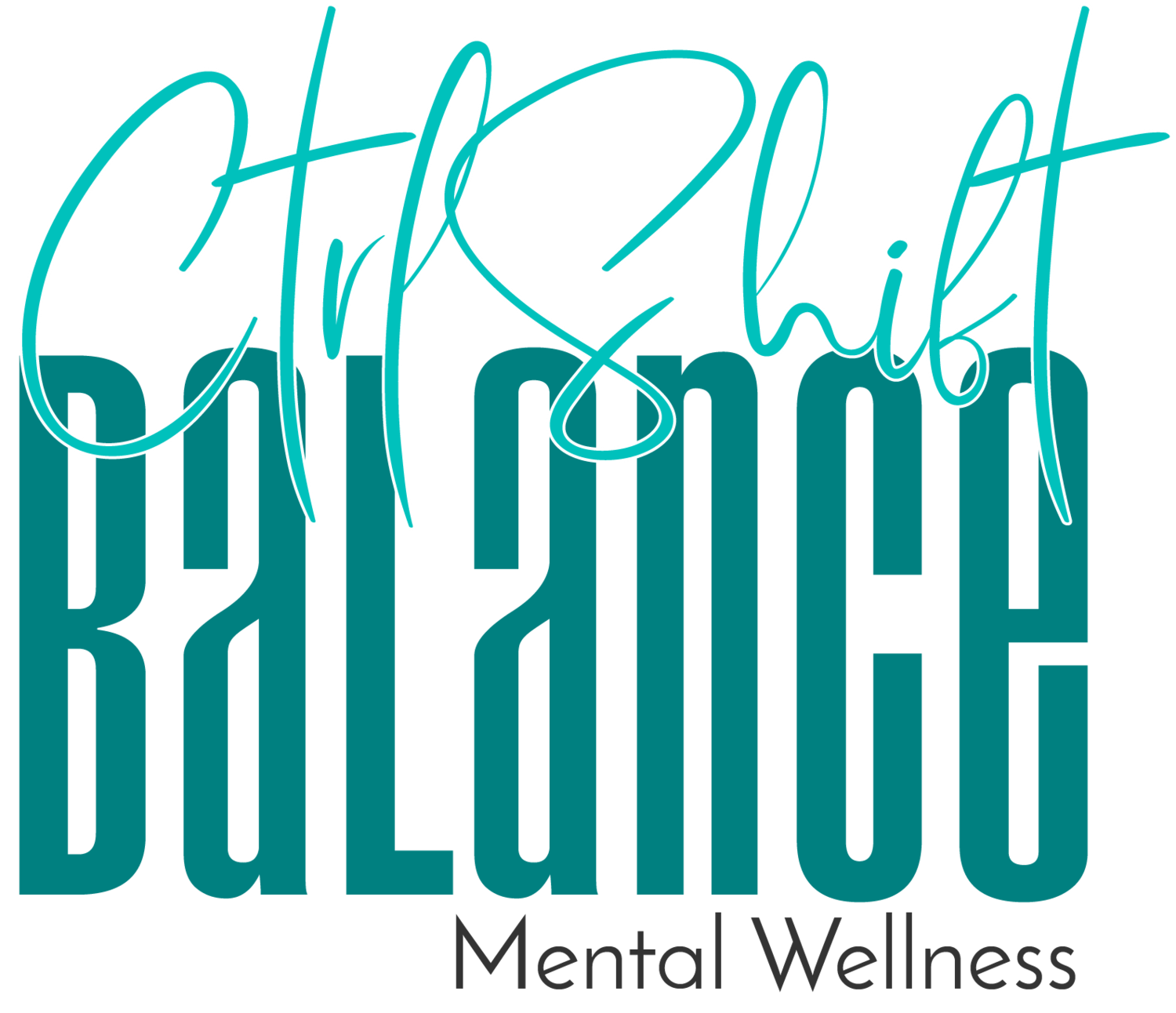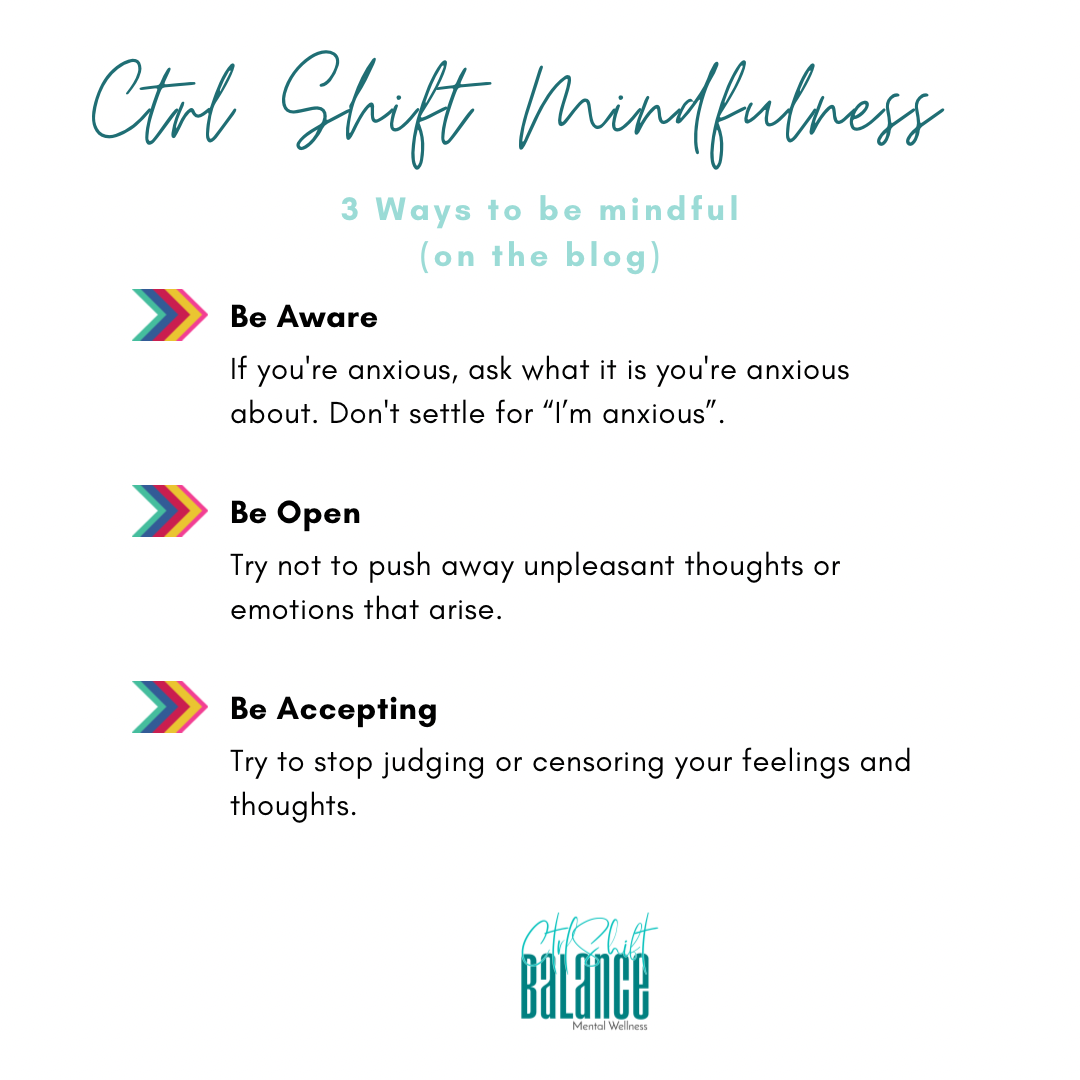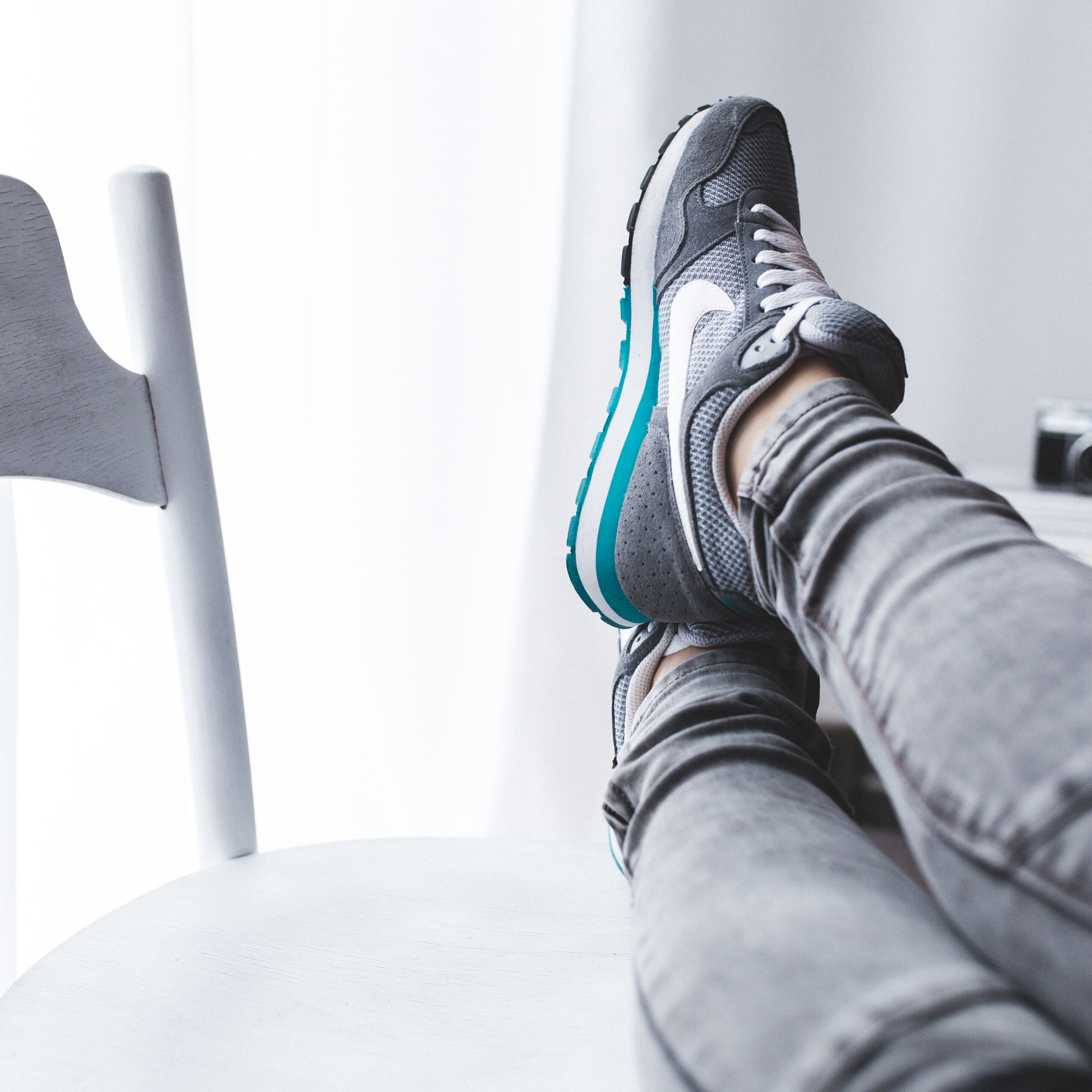
Ctrl Shift mindfulness
How to be more open, aware & present. Mindfulness—the practice of paying attention and staying present in the moment—has increasingly gained popularity in recent years. Perhaps this is because instead of spending even a second alone, staying present with our thoughts, we reflexively turn to our cell phones (I’m guilty of it at times) for entertainment, comfort, or distraction. Many of us are on our phones at work, in the bathroom - moments that in the past might have been spent unintentionally being mindful.
So how do we reclaim those mindful moments and again learn how to stay present, aware, and accepting of those moments?
Create Mindful Moments
Mindful moments are just small pauses in the business of life. They can be as short as a few breaths or as long as 10 or so minutes where we are actively present in the moment. Turn off the thoughts about the past or future and just notice what’s happening all around you. How do you feel? How do things look? How do things taste? etc...
The thing about being present and really paying attention is that we learn things about ourselves and our world that we might have been avoiding, perhaps with good reason. But we can deal with these thoughts and feelings once they come into the light.
When we try to just cope with emotions—like anxiety—the causes remain intact. Because mindfulness can help us better uncover and get at the causes, it can be a more effective way to increase well-being. But it’s important to note that mindfulness isn’t easy, so if it doesn’t work for you, that’s completely okay too.
Research suggests that people with severe trauma, depression, and other challenges like self-harm sometimes struggle with mindfulness. This is understandable since the roots of this emotional pain may be a lot harder to look at and deal with than other types of emotional pain. Please seek the support of a therapist if this is you and you want to use mindfulness.
How to Be Mindful
Even though mindfulness is theoretically possible to practice anywhere, that doesn’t mean it comes easy. Here’s some helpful tips:
To be more aware: If you're mad, ask what you're really mad at. If you're sad, ask what it is you're really sad at. If you're anxious, ask what it is you're anxious about. Don't settle for, "I'm mad at Devin because he was rude to me." Why does that rudeness matter? Why now? Why him? What is happening inside of you that makes you mad?
To be more open: Try not to push away unpleasant thoughts or emotions that arise. You might feel scared to cry in front of others or yell when you're angry. Try not to stifle those emotions. Instead, ask what might be leading you to stifle them. But also try not to generate excess emotions. Are you crying or yelling to get a specific reaction out of someone else? What are you hoping to achieve with your reactions? Try to stay present so you can just experience yourself as you are instead of trying to contort it into some kind of box.
To be more accepting: Try to stop judging or censoring your feelings and thoughts. Seriously, stop it! You may have heard judgy statements like “Boys don’t cry” or “You’re too sensitive” or “Get over it”, and you will, very likely, continue to hear these things. All you can do is refuse to judge yourself (or others), for having emotions. Emotions are natural and we all deserve ours.
Do a Quick Mindfulness Practice
Right now, try to create some negative emotions in yourself. An easy way to do this is to watch a movie or online video clip with a sad or emotional scene. Or if you’d like to challenge yourself, you could imagine something in your own life—for example, failing at something, being embarrassed in front of a crowd, or an injustice experienced by others that bothers you.
Once you have drummed up some negative emotions, stop thinking about the negative experiences and just be. See if you notice any interesting body sensations, emotions, or thoughts. Practice not ruminating on the experience but also not pushing the emotions away. Just be with yourself until your thoughts and emotions trail off.
If you finished this blog article feeling shaky, upset, or overwhelmed, mindfulness may not be for you. If, on the other hand, you feel more centered, calm, and content, keep using mindfulness to improve your life.
You may have additional questions on incorporating mindfulness in your day to day, let’s connect.
Your Partner in Balance,
Shayla Peterson
Ctrl Shift Rest
When we find ourselves in storms of life, it often takes a while to regain our perspective. Remember that REST is an anchor for you. Think about when the week is filled with meetings, projections and running errands after work; rest allows us to spend time alone and reassess our priorities. On the other hand, if we are constantly on the go not giving our mind and body rest, that is counterproductive to our Mental Wellness. Possibly leading to feelings of overwhelm, keyed up, frustrated, sad mood, isolation or complete shutdown from everything. That fact of the matter is it’s unbalanced. Find time for REST, it’s productive and necessary for your mental wellness.
One way to achieve quality REST is through a balanced schedule., a mix of work and play, family and friend, reading several chapters to a book and binge watching TV, you get it. Remember the importance of having necessary clarity of the mind to discern which responsibility we should take on which one needs to wait.
How will you schedule time for REST this weekend?
With Balance & Wellness,
Shayla Peterson, LCSW, LISW-CP
Ctrl Shift Grounding
Grounding Techniques to Reduce Stress during COVID-19
Grounding yourself in times of Stress during COVID-19.
During this time of uncertainty, people are experiencing increased stress relating to fear of illness, quarantine routine, job layoffs, milestones events being cancelled or loss of your ideal imagine of how events will be happen. These factors may have a lasting effects on during the years to come on ones financial, physical, emotional and mental health. I wanted to share one of my most use skills that I share with clients that I work with to reduce their stress levels not just in times of uncertainty but throughout other stressors in life.
Grounding Techniques are things that you can do to help you feel solid, soothed and connected to yours surroundings. It involves you deliberating using your attention to an experience that you are having that is not threatening. Incorporating grounding strategies are good for people who have a hard time staying mindful. Using grounding strategies incorporates your whole brain oppose to using only one side which could lead us to missing key information.
Incorporating grounding strategies can help you feel calm when you feel your stress is overwhelming you and break your “fight, flight or freeze” response that you may experience. During COVID, you may have already experienced these responses. I will share some tips with you that you can incorporate immediately to work towards stress relief.
Imagine yourself as big tree. Stretch your arms up to the sky and imagine branches and leaves. Dig your feet into the floor and imagine them growing roots.
Take off your shoes and walk slowly around the room, feeling connection between your feet and the carpet with each step Feel your toes, your sole, and your heel connecting with the carpet.
Describe three things in the room in terms of sensory qualities (color, shape, texture, size, smell, etc.)
Shake your body. Begin my wiggling your toes, then your ankles, your lower legs and them move to your upper legs. Then do the same with your arms, hands and fingers.
Breathe in for a count of 4, hold for a count of 4, breathe out for a count of 4, and then pause for a count of 4. Try to slow your breathing down with each time that your practice.
Imagine being a peaceful place, close to nature. Visualize yourself at the beach or overlooking the bay or in the forest or hiking on a trail or in a park or garden.
THERAPIST FAVORITE : Drink a cup of tea slowly. First feel the warmth of the cup. Then smell the aroma. Notice the color and texture of the tea Take a small sip and swirl it around your mouth. Now swallow. Notice the taste and feeling of the tea as it flow down your throat.
Suck on a peppermint (a sunday classic) or smell eucalyptus.
Draw, paint or color.
Rub your pet, hold them in your lap, notice their breathing and feel their warmth.
Take a warm bath or showing, cuddle in blanket and slip on fuzzy socks.
Listen to soothing music
Go for a walk in the neighborhood.
Once you start to feel grounded and solid, you can look at the stressful situation and your emotions about COVID-19 without feeling so overwhelming and chaotic. Grounding signal to particular part of your brain (the amygdala to be exact) that you are safe in the present moment, allowing it put a pause on your “fight, flight or freeze” response.
I hope that you find these grounding strategies help as we continue to face this crisis. Email me at shayla@ctrlshiftbalance.com and let me know which one has been helpful for you. If you would to work through to addressing your “Fight, Flight or Freeze” during a pandemic, schedule a free 15 minute consultation.
Be Balanced & Grounded,
Shayla Peterson, LCSW
Ctrl Shift Anxiety
There are many ways to approach anxiety. The simplest medos are also the known to be the best methods. I will explore those with in this blog in hope that you start to experience relief you need with minimal efforts.
Check out these strategies to worry less:
1. Ask yourself what you can do about it. There are many worries that are beyond your ability to influences. If you can do something about your concerns, by all means, do it. However, we know that many of the situations of worry can not be solved. Such as health issues of family member, weather for next Saturday, weather or not you get that promotion or even Politics.
2. Get more rest. A lack of sleep leads to increased anxiety. An extra hour of sleep each night can make a big difference.
3. Find somethings else to do. If worrying and anxiety are getting the best of you, try distracting yourself. You might think, “that’s not going to solve anything.” True, but neither will worrying. You might as well enjoy yourself as much as possible in the meantime.
4. Adopt Powerful Body Language. Strong Powerful Body Language can change your mood and attitude Try standing like a powerful that has control over her life. Lift your head up, sit up straight, chest out, smile, take up space, give a strong handshake, relax yourself and make good eye contact. For a bonus, watch movies with powerful, confidence characters and notice how they move and stand.
5. Laugh. You have a couple of memories or stories that always make you laugh when you think about them and share them Have these memories ready to go a moment’s notice.
Try out these tips to shift your perspective on managing your worries and anxiety. Next week, I will shared tip 6 through 10. Let me know how the first 5 have worked for you by emailing at shayla@ctrlshiftbalance.com.
Be Balanced & Well,
Shayla






